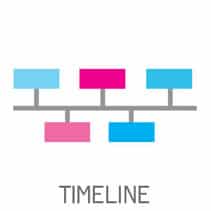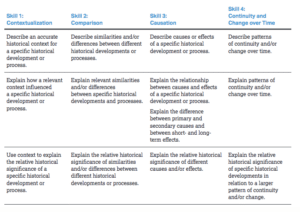
If you are taking the APUSH exam, you know that there’s a lot of material to understand.
Like, a lot.
Studying is key to doing well on this exam, and if you continue reading this post, you will get some great ideas to help you organize your APUSH material in a useful US history timeline.
Why should I study with a timeline?
I am sure that if you are taking the APUSH exam, you have your own study tips and tricks to help you prepare. But just humor me for a second with the timeline idea.
The APUSH exam is trying to see how well you can think historically, a concept I explain in more detail in this blog post. These historical thinking skills are:
1. Contextualization
2. Comparison
3. Causation
4. Continuity and Change over time
You can do yourself a huge favor and study each one of these 4 C’s through organizing content in a timeline. Don’t believe me? Keep reading. (If you are already on board as to why you should study with a timeline, skip ahead to the ‘What timeline should I use to study for the APUSH exam?’ section.)
AP History Reasoning Skills (Source: here)

For all of these skills, a timeline will help you make sense of what was relevant at a particular historical moment to compare similarities and differences between two or more events, the causal relationship between those events, and how events may have changed or remained the same over time.
In other words, timelines rock for studying for the APUSH exam!
What timeline should I use to study for the APUSH exam?
Most resources will give you timelines that are centered around the periods that you need to know for the APUSH exam. This makes sense, as this is how most of the content is organized that you will learn.
However, the APUSH exam has you going beyond rote memorization and asks you to synthesize and analyze information, too. The standard periods will not be enough.
Instead, I am suggesting that you use both the standard periods and the themes for the APUSH exam to create your timeline. Follow along to create your own.
Step 1: Create the template for your timeline.
You can create a standard timeline that has the long line and information above or below it if you wish. For the purposes of this blog post, however, I will show you a table with the standard periods and the APUSH themes. See below the table for the key of abbreviations.
| NAT | POL | WXT | CUL | MIG | GEO | WOR | |
| Period 1: 1491-1607 | |||||||
| Period 2: 1607-1754 | |||||||
| Period 3: 1754-1800 | |||||||
| Period 4: 1800-1848 | |||||||
| Period 5: 1844-1877 | |||||||
| Period 6: 1865-1898 | |||||||
| Period 7: 1890-1945 | |||||||
| Period 8: 1945-1980 | |||||||
| Period 9: 1980-Present |
NAT: American and National Identity
POL: Politics and Power
WXT: Work, Exchange, and Technology
CUL: Culture and Society
MIG: Migration and Settlement
GEO: Geography and the Environment
WOR: America in the World
If you decide to go the more traditional timeline route, I suggest that you have lines for the time periods and different colors for the themes. However, as is always the case, choose the best organization system for you.
Step 2: Start filling in your timeline.
Here’s where the fun begins.
You have quite a few options for populating your timeline. You could go with a time period and fill in all the relevant themes or you could start with a theme and fill in the details for the time period. I prefer the second approach.
So let’s start with a theme, like MIG (Migration and Settlement).
Before I fill in this timeline, it’s going to be important for me to figure out what those words mean in the context of this APUSH theme. Thankfully, the College Board (the makers of the APUSH exam) have provided what the theme means here. You could also ask for clarification from your history teacher if the College Board isn’t making sense (or comment here and I will respond to your question!).
Back to the MIG theme. The College Board states that “this theme focuses on why and how the various people who moved to and within the United States both adapted to and transformed their new social and physical environments.” We would be here all day if I went through the entire theme with you, but let’s take one period, just to get started. I’m choosing Period 4: 1800-1848.
There’s a lot happening in this time period. We have more traditional immigration happening from Ireland (as a result of a massive famine), Germany (economic opportunity and available farmland in the midwest), and China (the Gold Rush on the West coast). The Atlantic slave trade does not end until 1807 – we should put it in this period. And the domestic slave trade continued on, especially after the purchase of the Louisiana Territory in 1803; “By the 1830s, Virginia’s largest export was human property,” says Steven Deyle, associate professor of history at the University of Houston and author of Carry Me Back: The Domestic Slave Trade in American Life.
And as I wrote in my blog post about the Indian Removal Act, indigenous people in the United States were forcibly removed from their lands in the southeastern United States and settled on reservations in the Northwest and West.
Don’t worry about putting every single detail in your US history timeline; instead, your timeline should act as a snapshot that you can reference to get ideas. Use dates, keywords, and phrases – not complete sentences – when creating your timeline.
Step 3. Collaborate and refine.
All good work comes from collaborating with knowledgeable peers. Create a study group that works on completing the timeline after completing a period in class. Or consult one of these resources to help you get a full scope of the APUSH exam:
1. Gilder Lehrman
2. Crash Course
3. Stanford History Education Group
Whatever you do, do not wait until the last minute to complete your timeline. I’ll repeat that.
**DO NOT WAIT UNTIL THE LAST MINUTE TO COMPLETE YOUR TIMELINE.**
The benefit of the timeline is for you to add on and refine your knowledge, not cram for a test. As you can tell, this would be way too much information to cram anyway.
Start creating your timeline as early as possible, and keep coming back to it as you study throughout the year.
Once I have created my timeline for the APUSH exam, I don’t need to study anymore, right?
NO!
You should use your timeline as a tool to help you study.
After you have created your timeline, think about those historical thinking skills I mentioned earlier. See what questions you could be asked that would require you to contextualize, compare, describe causality, and identify change and continuity over time. And after you’ve done that, check out past APUSH exams that would help you continue to practice these skills!
It’ll be a lot of work, but you can do it.
Let us know how you created your own timeline in the comments below.
And happy studying!


Leave a Reply